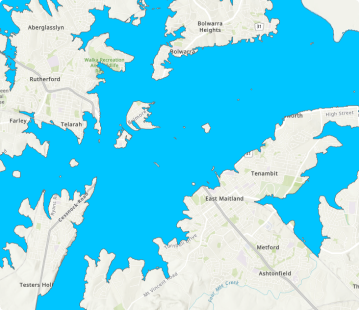Be prepared in an emergency
Being prepared can help you and your loved ones make better decisions during a disaster. It can save you money and heartbreak, and could even save your life.
There are five (5) simple steps you can take to Get Ready now:
- Know your risk
Think about the area you live in and the types of disasters that could affect you. - Plan for what you'll do
Sit down and talk with your family and plan for what you will do if a disaster affects your area. - Get your home ready
Prepare your home by doing general home maintenance and checking your insurance. - Be aware
Find out how to prepare and what to do if there is a disaster in your area. Connect with NSW Emergency Services to stay informed. - Look out for each other
Share information with your family, friends, neighbours, and those needing assistance.
Resources
Flooding in Maitland
Maitland is located on the floodplain of the Hunter and Paterson Rivers. It is important to understand flood risks and find ways to live with them. Our flood maps inform individuals, households and communities about the possible extent of flooding.
For more detailed flooding information specific to your property, request a flood certificate via MyCouncil.
Our flood maps

Understanding your flood risk
Our flood maps show areas that are at risk of flooding and help you identify potential hazards, so you can make informed decisions to protect yourself and your property.
Flooding can also occur in areas outside of what has been identified by flood maps, particularly during extreme weather that can overwhelm drainage.
Home fire safety
Smoke alarms
Smoke alarms are a life saving devices. Under Division 7A of Part 9 of the Environmental Planning and Assessment Regulation 2000, all residential dwellings in NSW must have at least one (1) working smoke alarm installed in each level of their home. This includes all owner-occupied, rental properties, relocatable homes and other residential buildings where people sleep.
All smoke alarms can either be:
- Battery operated smoke alarm with a hush button, or
- Hardwired 240 Volts smoke alarm with battery backup (must be installed by a licensed electrician)
Dwellings, alterations and additions built since 1993 must have hardwired smoke alarms to comply with the Building Code of Australia.
Controlled burning in Maitland
The burning of dead or dry vegetation in Maitland is guided by the Control of Burning Policy. The policy states that the burning of anything in Maitland is prohibited except in accordance with prior approval under the Protection of the Environment Operations (Clean Air) Regulation or the Rural Fire Act 1997.
You can only burn dead and dry vegetation on your land if:
- The vegetation your burning grew there
- The land is more than 4,000 square metres, and
- Your land is zoned as RU1 Primary Production, RU2 Rural Landscape or R5 Large Lot Residential.
Items prohibited to be burnt include:
- Tyres
- Coated wire
- Paint containers and residues
- Solvent containers and residues
- Timber treated with copper chromium arsenate (CCA) or pentachlorophenol (PCP).
Recreational fires
You can have open fires for recreational purposes, such as cooking, camping, picnicing or similar outdoor activities, however there are some restrictions:
- You must only use dry, seasoned wood
- You must only use liquid petroleum gas (LPG), natural gas or proprietary barbecue fuel.
At least 24 hours prior to lighting an open fire, contact the Lower Hunter Rural Fire Service on 02 4015 0000. If you’re planning to burn on a weekend, make sure to call between 9am and 4:30pm on the Friday prior.
Before burning, check current NSW Fire restrictions, such as No Burn Days and Total fire bans.
Reducing woodsmoke
Wood heaters are often used to heat our homes, however, they can be a major contributor to air pollution and can also have harmful affects on our health.
To reduce woodsmoke:
- Clean your chimney yearly
- Use only small logs of dry, aged, untreated wood
- Never dampen down your fire or let smoulder overnight
- Consider cleaner heating alternatives
For more information on smoke safety, visit NSW EPA.
Fire safety for building and development
All building owners are responsible for protecting their building and occupants in the event of a fire under the guidance of the Environmental Planning and Assessment (Development Certification & Fire Safety) Regulation 2021.
A fire safety certificate must be obtained when building work is complete. The certificate confirms that a qualified person has installed and checked all required fire safety measures applying to the building. They must also submit a fire safety statement confirming that a qualified person has assessed, inspected and verified the performance of each fire safety measure in the building. The building owner must also make sure a copy is clearly displayed within the building.

